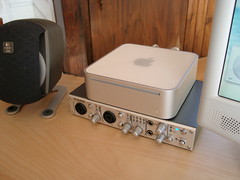
I get more comments and mail about my Cloudlifter review. This question comes courtesy of Scully:
Hmm. Maybe I should get one [an H4n]. The SM57 sounds smooth with the H4n. I'm currently trying an SM57 with a dbx 286A + CL-1 to an Edirol R-09HR. I'm also swapping out the dbx for an Edirol UA25. In both cases it just sounds too... "dry." Your voice sounds smooth, and I don't think it's just your voice.Whoa. Scully. Pump the brakes.
If I find out that, with the gear you already own, you went out and bought a $300 portable recording unit JUST to make an SM57 sound better, I swear to a deity I don't believe in, I will find where you live, drive there, and deliver a swift kick up the arse.
Couple things you can try:
- Play with mic position. It's sort of like a stage actor finding their light. Move around. Change the position and angle in your booth. Move the mic around. Find that sweet spot.
- Try different locations. Do you usually record in a small space? Go bigger. Typically recording in a large space? Go small.
- Check out your preamp settings. Maybe your dbx is hitting the compressor to hard? Maybe the de-esser or expander is getting in the way?
I like to record as clean as possible. Usually I'll go solely preamp, sometimes I'll throw in a compressor as a safety net, but I never use any other gear to affect the sound of spoken word.
I'll always recommend working backwards. Disable everything you can to work with as simple a recording chain as possible, and with THAT see if you can achieve the sound you want.
After that, then it's easy to replace a de-esser or compressor, since they wont be used to CREATE the sound you want, they'll only be there to protect it.
Shop for the Zoom H4n, Edirol UA25, Shure SM57, or dbx 286A, and you'll be supporting this site at no additional cost to you! Looking for different gear? Hit the shop links on the left!









